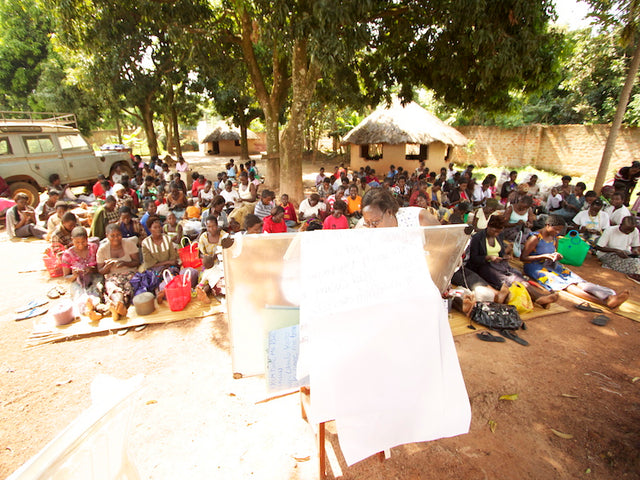Measuring Social Impact
 In my last blog post I wrote about the importance of demanding real social impact from businesses and non-profits that claim to be helping people. In this post I take the conversation a step further by explaining how we measure our social impact and why it is pivotal to empowering people to rise above poverty.
Empowerment is a complex process, therefore tracking it requires a comprehensive measurement system. We all experience poverty and wellbeing in the six areas of our personhood: financially, intellectually, physically, socially, psychologically and spiritually (read more about our theory of change). For someone to be truly empowered they must be thriving in all of these areas. Given this, it’s not true to say that someone is empowered because they can send their kids to school or eat more nutritious food. These are great victories, but only give us insight into one area of the individual’s wellbeing. To truly measure empowerment we have to look at it through a more holistic lens that encapsulates the entire individual.
To give us insight into the social impact that results from our work we developed a robust system for tracking empowerment that includes all areas of the individual. The key to our system is that it breaks down the complexity of poverty into a set of indicators that are measureable. Each of these indicators gives us insight into a specific area of someone’s wellbeing. When we look at these indicators together we get a holistic perspective of a person’s overall wellbeing. Think of the system like a painting. A painting is made up of many individual brush strokes that make up a beautiful image. In the same way our indicators are a set of individuals life-circumstances that when viewed together paint a vibrant picture of someone’s overall wellbeing.
Below are the indicators that we measure.
In my last blog post I wrote about the importance of demanding real social impact from businesses and non-profits that claim to be helping people. In this post I take the conversation a step further by explaining how we measure our social impact and why it is pivotal to empowering people to rise above poverty.
Empowerment is a complex process, therefore tracking it requires a comprehensive measurement system. We all experience poverty and wellbeing in the six areas of our personhood: financially, intellectually, physically, socially, psychologically and spiritually (read more about our theory of change). For someone to be truly empowered they must be thriving in all of these areas. Given this, it’s not true to say that someone is empowered because they can send their kids to school or eat more nutritious food. These are great victories, but only give us insight into one area of the individual’s wellbeing. To truly measure empowerment we have to look at it through a more holistic lens that encapsulates the entire individual.
To give us insight into the social impact that results from our work we developed a robust system for tracking empowerment that includes all areas of the individual. The key to our system is that it breaks down the complexity of poverty into a set of indicators that are measureable. Each of these indicators gives us insight into a specific area of someone’s wellbeing. When we look at these indicators together we get a holistic perspective of a person’s overall wellbeing. Think of the system like a painting. A painting is made up of many individual brush strokes that make up a beautiful image. In the same way our indicators are a set of individuals life-circumstances that when viewed together paint a vibrant picture of someone’s overall wellbeing.
Below are the indicators that we measure.
 We track these indicators for every person in the program, every month. The result is real-time data on where each woman is currently at in the empowerment process. We use this data in three ways:
1. To demonstrate impact to consumers and donors. When a person supports KKi by purchasing a product and/or making a donation we want to prove to them that they are having a profound impact in a woman’s life.
2. To provide unique services to every individual we work with. Every person’s journey towards empowerment is unique and therefore requires a set of services that are uniquely tailored to them. Our mentors are constantly reviewing the indicators and can easily identify the areas that a person is struggling in. For example, if our data indicates that a participant and her family are suffering from waterborne illnesses month after month, her mentor will see this and can respond with the appropriate training and mentorship on where to access a clean water source.
3. To course-correct our services to facilitate more social impact. We are constantly improving our job, education and mentorship initiatives so that they result in the highest level of empowerment. By measuring the social impact that occurs as a result of our services we gain insight into whether they are working or not. For example, this month we are finishing a training series on savings in Peru that resulted in the participants doubling their savings in less than four months. As a result we know that the training series was successful and we can move onto another series. If we didn’t see an immediate impact we would know to go back and retrain the series until our savings impact goals are met.
By tracking our social impact through a robust M&E system we are gaining valuable insight into how effective our programs are at facilitating empowerment in Uganda and Peru. What we learn from today’s social impact data helps us develop a stronger and more relevant program for tomorrow. Ultimately, that means more empowerment for the women that participate in our program.
We track these indicators for every person in the program, every month. The result is real-time data on where each woman is currently at in the empowerment process. We use this data in three ways:
1. To demonstrate impact to consumers and donors. When a person supports KKi by purchasing a product and/or making a donation we want to prove to them that they are having a profound impact in a woman’s life.
2. To provide unique services to every individual we work with. Every person’s journey towards empowerment is unique and therefore requires a set of services that are uniquely tailored to them. Our mentors are constantly reviewing the indicators and can easily identify the areas that a person is struggling in. For example, if our data indicates that a participant and her family are suffering from waterborne illnesses month after month, her mentor will see this and can respond with the appropriate training and mentorship on where to access a clean water source.
3. To course-correct our services to facilitate more social impact. We are constantly improving our job, education and mentorship initiatives so that they result in the highest level of empowerment. By measuring the social impact that occurs as a result of our services we gain insight into whether they are working or not. For example, this month we are finishing a training series on savings in Peru that resulted in the participants doubling their savings in less than four months. As a result we know that the training series was successful and we can move onto another series. If we didn’t see an immediate impact we would know to go back and retrain the series until our savings impact goals are met.
By tracking our social impact through a robust M&E system we are gaining valuable insight into how effective our programs are at facilitating empowerment in Uganda and Peru. What we learn from today’s social impact data helps us develop a stronger and more relevant program for tomorrow. Ultimately, that means more empowerment for the women that participate in our program.


0 Comments
There are no comments yet. Be the first one to post one!